

Buddhist Bhavana: Introduction to Buddhist Meditation. Buddhist meditation takes many forms, but all of them are bhavana.
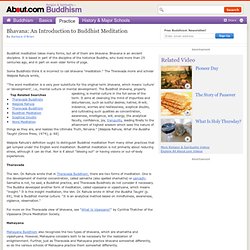
Bhavana is an ancient discipline. It is based in part of the discipline of the historical Buddha, who lived more than 25 centuries ago, and in part on even older forms of yoga. Some Buddhists think it is incorrect to call bhavana "meditation. " The Theravada monk and scholar Walpola Rahula wrote, "The word meditation is a very poor substitute for the original term bhavana, which means 'culture' or 'development', i.e., mental culture or mental development. Walpola Rahula's definition ought to distinguish Buddhist meditation from many other practices that get lumped under the English word meditation. Theravada The Ven. For more on the Theravada view of bhavana, see "What Is Vipassana?
" Mahayana Mahayana Buddhism also recognizes the two types of bhavana, which are shamatha and vipashyana. For example, the Tiantai (Tendai in Japan) school of Buddhism calls its bhavana practice by the Chinese name zhiguan (shikan in Japanese). BUDDHIST PRAYER. BUDDHIST PRAYERS OF LOVE. What Is the Self: What Buddhism Teaches About the Self.
Among all the Buddha's teachings, those on the nature of the self are the hardest to understand, yet they are central to the religion.
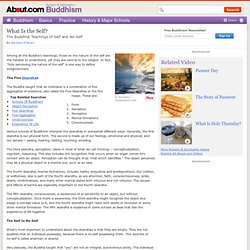
In fact, "fully perceiving the nature of the self" is one way to define enlightenment. The Five Skandhas The Buddha taught that an individual is a combination of five aggregates of existence, also called the Five Skandhas or the five heaps. These are: Form Sensation Perception Mental formations Consciousness Various schools of Buddhism interpret the skandhas in somewhat different ways. The third skandha, perception, takes in most of what we call thinking -- conceptualization, cognition, reasoning. The fourth skandha, mental formations, includes habits, prejudices and predispositions. The fifth skandha, consciousness, is awareness of or sensitivity to an object, but without conceptualization.
The Self Is No-Self What's most important to understand about the skandhas is that they are empty. On the surface, this appears to be a nihilistic teaching. Two Views. Buddhist Path to Enlightenment. Four Noble Truths - The Four Noble Truths of Buddhism. By Barbara O'Brien Updated March 31, 2015.

Buddhist Precepts - Introduction to the Buddhist Precepts. Most religions have moral and ethical rules and commandments.
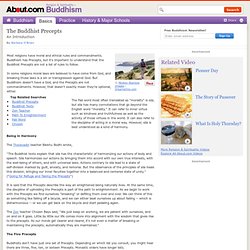
Buddhism has Precepts, but it's important to understand that the Buddhist Precepts are not a list of rules to follow. In some religions moral laws are believed to have come from God, and breaking those laws is a sin or transgression against God. But Buddhism doesn't have a God, and the Precepts are not commandments. However, that doesn't exactly mean they're optional, either. The Pali word most often translated as "morality" is sila, but sila has many connotations that go beyond the English word "morality.
" Being in Harmony The Theravadin teacher Bikkhu Bodhi wrote, "The Buddhist texts explain that sila has the characteristic of harmonizing our actions of body and speech. It is said that the Precepts describe the way an enlightened being naturally lives. The Zen teacher Chozen Bays said, "We just keep on working, we are patient with ourselves, and on and on it goes. The Practice of Buddhism. Being a Buddhist is not a matter of accepting a belief system or memorizing doctrines.
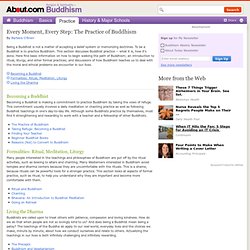
To be a Buddhist is to practice Buddhism. This section discusses Buddhist practice -- what it is, how it's done. Here find basic information on how to begin walking the path of Buddhism; an introduction to ritual, liturgy, and other formal practices; and discussions of how Buddhism teaches us to deal with the moral and ethical problems we encounter in our lives. Becoming a Buddhist Becoming a Buddhist is making a commitment to practice Buddhism by taking the vows of refuge. Formalities: Ritual, Meditation, Liturgy Many people interested in the teachings and philosophies of Buddhism are put off by the ritual activities, such as bowing to altars and chanting. Living the Dharma Buddhists are called upon to treat others with patience, compassion and loving kindness. Buddhism Beliefs. Buddhism Practices. Buddhism has changed and adapted to every culture it encountered after it began in the north of India.
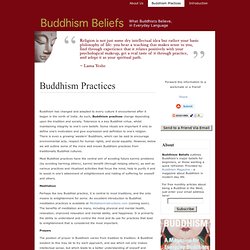
As such, Buddhism practices change depending upon the tradition and society. Tolerance is a key Buddhist virtue, whilst maintaining integrity to one’s core beliefs. Some rituals are important if only to define one’s motivation and give expression and definition to one’s religion. There is even a growing ‘western’ Buddhism, which can be said to encourage environmental acts, respect for human rights, and social equality. However, below we will outline some of the more well known Buddhism practices from traditionally Buddhist cultures.
Most Buddhist practices have the central aim of avoiding future karmic problems (by avoiding harming others), karmic benefit (through helping others), as well as various practices and ritualized activities that focus the mind, help to purify it and to assist in one’s attainment of enlightenment and ridding of suffering for oneself and others. Meditation. BUDDHIST BELIEFS, PRACTICES AND EXPERIENCES.